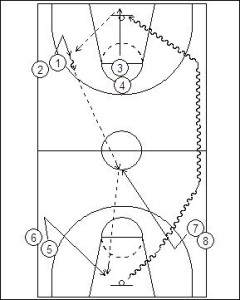Father Judge Passing Drill
The Father Judge Passing Drill looks to help players with leading for the ball and passing in the full court. All too often drills which focus on passing fail to do so in game realistic movements, focusing more on the accuracy and making the distance in passing rather than the tactical aspects. The Father Judge Passing Drill looks to provide player with a number of different opportunities to practice receiving the ball when being advanced down the floor. This is truly a very rare and powerful aspect of the drill.
Positioning players to then perform a lead for the ball in the full court is such a rarely practiced technique. While in the diagram below the players are positioned in specific spots on the floor. These can of course be altered to be more reflective of a team’s primary transition.
Another useful aspect of the Father Judge Passing Drill is the dribbling of the ball once it has been advanced from one end of the floor to the other. This is a really great feature as players can practice utilising a speed dribble which is underutilised fundamental technique. When using the speed dribble scoring from a lay-up is one of the most inconsistent shots in basketball. Just think about how many times in games you see a player out in front of the defence running to the open basket only to miss the uncontested lay-up in many different ways.

The drill starts with a rebound by player Three (3) throwing the basketball off the backboard and performing a textbook rebound. Three (3) should finish in a jump stop and forward pivot towards the outlet target One (1).
As Three (3) is catching the ball, One (1) must start to create a lead for the ball. This lead can be in any number of directions but should take their defender away from the desired catching position for the outlet pass.
One (1) once receiving the outlet pass then makes a hard dribble towards the centre circle and passes to Seven (7) who is leading back for the ball.
Seven (7) should start to make their lead for the ball as One (1) is changing direction in creating a lead for the ball.
Seven (7) catches the ball and “rips” it through to square up to the basket. It is important for Seven (7) to square up to the basket and too see the whole floor ahead of them. In a game, this will allow the player to see the whole floor and assist in making the best possible choice on to whom to pass the ball to.
After viewing the floor briefly Seven (7) looks to advance the ball by passing to Five (5) who is making a backdoor cut. After player Five (5) has made a lay-up (two step or power lay-up) they pull the ball from the net of the basket and dribble as fast as they can down the opposite side of the floor.
Rotations for the Drill
- 1 to 7 Follow pass
- 7 to 5 Follow pass
- 5 to 3 Move to nearest line
- 4 to 1 Follow pass
Variations
One of the more significant variations that a coach should look into is to change the line-up of the receivers to mirror the team’s playbook for offensive transition. Players will then be able to practice the different leads and cuts for the ball in a more purposeful and specific manner to within the team offense.
Another option is to add defenders to each of the receiver spots so now the offensive player is competing against a live match-up. In this situation, the players simply rotate from offensive to defence and then onto the next line once they have filled both roles.
The Father Judge Passing Drill is one of the better full court passing drills around. It can be varied significantly to more closely align to the team’s specific offensive principles. Like any drill, the basic elements are great for development, but as players progress the drills need to reflect the offensive structures more and more.







